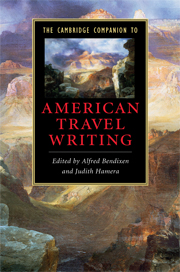Book contents
- Frontmatter
- Introduction: new worlds and old lands - the travel book and the construction of American identity
- Part I Confronting the American landscape
- Part II Americans abroad
- 6 American travel books about Europe before the Civil War
- 7 Americans in Europe from Henry James to the present
- 8 Americans in the Holy Land, Israel, and Palestine
- 9 Americans in the larger world: beyond the Pacific coast
- 10 South of the border: American travel writing in Latin America
- Part III Social scenes and American sites
- Chronology
- Further Reading
- Index
9 - Americans in the larger world: beyond the Pacific coast
from Part II - Americans abroad
Published online by Cambridge University Press: 28 March 2009
- Frontmatter
- Introduction: new worlds and old lands - the travel book and the construction of American identity
- Part I Confronting the American landscape
- Part II Americans abroad
- 6 American travel books about Europe before the Civil War
- 7 Americans in Europe from Henry James to the present
- 8 Americans in the Holy Land, Israel, and Palestine
- 9 Americans in the larger world: beyond the Pacific coast
- 10 South of the border: American travel writing in Latin America
- Part III Social scenes and American sites
- Chronology
- Further Reading
- Index
Summary
This chapter examines travel writing by Americans during the nineteenth and early twentieth centuries that focuses on extra-continental journeys to islands. Although America was initially “discovered” by sea, the settlement of the United States by immigrants focused largely on filling the empty spaces on the continental map. However, by the mid-nineteenth century, the Western frontier was rapidly vanishing as the transcontinental railroad, telegraph service, and steamships emerged. Needing more land, the nation looked abroad, turning its attention towards the islands of the South Pacific, Cuba, and Hawaii. As the land frontier closed, the sea voyage became important for both imperial and literary exploration. The travel writing that results enables us to understand the relationship between American colonial and literary activity abroad. To begin the study of American travel to the South Pacific, we must acknowledge the place the Marquesas Islands hold in the history of American imperialism. In 1815, American naval captain David Porter proposed to President James Madison that he be allowed to lead an American exploration voyage to the Pacific in order to explore potential commercial development and pursue military colonization. After his arrival at Nukuheva, Porter notified President Madison and Secretary of State James Monroe that he had annexed the Marquesas in the name of the United States. Though neither acknowledged Porter's letters, Porter's claim established these islands in the American imagination as a possible site for overseas expansion and trade. As a result, subsequent writers adopted this model of conquest in their attitudes towards foreign cultures.
- Type
- Chapter
- Information
- The Cambridge Companion to American Travel Writing , pp. 165 - 179Publisher: Cambridge University PressPrint publication year: 2009

